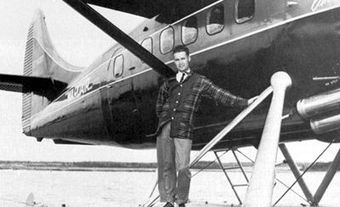This content is from a series created in partnership with Museum Services of the City of Toronto and Heritage Toronto. We gratefully acknowledge funding from the Ontario Ministry of Tourism, Culture and Sport, and the Department of Canadian Heritage.
Toronto Feature: Billy Bishop Toronto City Airport
"Island Airport's Long Aviation History"
On 14 May 1921, the Santa Maria soared into Toronto's imagination when it made a brief stop en route to Detroit, Mich, where it would herald a new passenger service to Cleveland, Ohio. The Santa Maria was a converted US Navy F5L (a Curtiss Flying Boat). It would soon accommodate passengers in a cabin luxuriously appointed in mahogany and silver. Crowds watched the big plane berth at the Toronto Harbour Commission's headquarters while steamships blew their whistles in welcome. Its commander, Captain Theodore Tibbs, a Torontonian and Royal Air Force veteran, addressed the crowd, drawing cheers and applause when he suggested a similar service between Toronto and Buffalo, New York. It was a harbinger of things to come.
During the 1920s, Toronto was determined not to be left behind by the Trans-Canada Airway Development Program. The Harbour Commission formed an ambitious plan that would integrate an aircraft terminal with a modern port. City council gave its approval in 1937 for two aerodromes--a main one south of the Western Channel and an all-weather backup at Malton, northwest of Toronto.
The island airport required extensive lakefilling and the relocation of cottages to Algonquin Island. The baseball stadium and amusement park at Hanlan's Point were demolished. Officially named the Port George VI Airport, it was completed in 1939, two years after Malton.
At the onset of the Second World War, war-related industries and training facilities expanded Malton. The Island Airport became a training base for the Royal Norwegian Air Force, which relocated in 1943, leaving the camp to the Royal Canadian Air Force.
After the war, Malton remained the base for major airlines. At the Island Airport, commercial traffic resumed. A series of proposals and reviews would define its niche--serving business travelers who value its proximity to downtown. It became the Billy Bishop Toronto City Airport in 2009.

 Partager sur Facebook
Partager sur Facebook Partager sur X
Partager sur X Partager par Email
Partager par Email Partager sur Google Classroom
Partager sur Google Classroom





